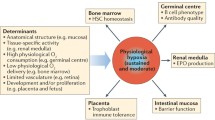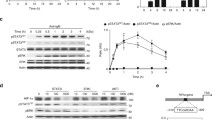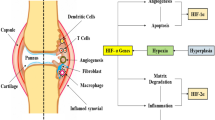Abstract
Hypoxia elicits an orchestrated response in cells, tissues, and entire organisms to survive a hypoxic challenge. On a molecular level, this response can be controlled by oxygen-dependent stabilization of the transcription factor hypoxia-inducible factor (HIF)-1α. Recently, studies have shown that HIF-1α plays an important role in the development and function of T helper (Th) cells, regulatory T (Treg) cells, and dendritic cells (DCs). Because these cells are critical in the pathogenesis of autoimmune diseases, such as systemic lupus erythematosus and rheumatoid arthritis, the roles of HIF-1α in these autoimmune disorders cannot be neglected. In this review, we discuss recent findings on the important roles of HIF-1α in immune cells and the possible pathologic roles of HIF-1α in autoimmune diseases. The obtained information may lead to deeper insights into the roles of HIF-1α in these disorders.

Similar content being viewed by others
References
Dehne, N., and B. Brüne. 2009. HIF-1 in the inflammatory microenvironment. Experimental Cell Research 315: 1791–1797.
Semenza, G.L. 1999. Regulation of mammalian O2 homeostasis by hypoxia-inducible factor 1. Annual Review of Cell and Developmental Biology 15: 551–578.
Pugh, C.W., G.W. Chang, M. Cockman, A.C. Epstein, J.M. Gleadle, P.H. Maxwell, et al. 1999. Regulation of gene expression by oxygen levels in mammalian cells. Advances in Nephrology from the Necker Hospital 29: 191–206.
Sowter, H.M., P.J. Ratcliffe, P. Watson, A.H. Greenberg, and A.L. Harris. 2001. HIF-1-dependent regulation of hypoxic induction of the cell death factors BNIP3 and NIX in human tumors. Cancer Research 61: 6669–6673.
Keith, B., R.S. Johnson, and M.C. Simon. 2011. HIF1α and HIF2α: sibling rivalry in hypoxic tumour growth and progression. Nature Reviews in Cancer 12: 9–22.
Forristal, C.E., K.L. Wright, N.A. Hanley, R.O. Oreffo, and F.D. Houghton. 2010. Hypoxia inducible factors regulate pluripotency and proliferation in human embryonic stem cells cultured at reduced oxygen tensions. Reproduction 139: 85–97.
Clambey, E.T., E.N. McNamee, J.A. Westrich, L.E. Glover, E.L. Campbell, P. Jedlicka, et al. 2012. Hypoxia-inducible factor-1 alpha-dependent induction of FoxP3 drives regulatory T-cell abundance and function during inflammatory hypoxia of the mucosa. Proceedings of the National Academy of Sciences of the United States of America 109: E2784–E2793.
Ben-Shoshan, J., S. Maysel-Auslender, A. Mor, G. Keren, and J. George. 2008. Hypoxia controls CD4 + CD25+ regulatory T-cell homeostasis via hypoxia-inducible factor-1alpha. European Journal of Immunology 38: 2412–2418.
Wu, J., H. Cui, Z. Zhu, L. Wang, H. Li, and D. Wang. 2014. Effect of HIF1α on Foxp3 expression in CD4+ CD25− T lymphocytes. Microbiology and Immunology 58: 409–415.
Shi, L.Z., R. Wang, G. Huang, P. Vogel, G. Neale, D.R. Green, et al. 2011. HIF1alpha-dependent glycolytic pathway orchestrates a metabolic checkpoint for the differentiation of TH17 and Treg cells. Journal of Experimental Medicine 208: 1367–1376.
Filippi, I., E. Morena, C. Aldinucci, F. Carraro, S. Sozzani, and A. Naldini. 2014. Short-term hypoxia enhances the migratory capability of dendritic cell through HIF-1α and PI3K/Akt pathway. Journal of Cellular Physiology 229: 2067–2076.
Köhler, T., B. Reizis, R.S. Johnson, H. Weighardt, and I. Förster. 2012. Influence of hypoxia-inducible factor 1α on dendritic cell differentiation and migration. European Journal of Immunology 42: 1226–1236.
Jantsch, J., D. Chakravortty, N. Turza, A.T. Prechtel, B. Buchholz, R.G. Gerlach, et al. 2008. Hypoxia and hypoxia-inducible factor-1 alpha modulate lipopolysaccharide-induced dendritic cell activation and function. Journal of Immunology 180: 4697–4705.
Ma, C., J. Wei, F. Zhan, R. Wang, K. Fu, X. Wan, et al. 2012. Urinary hypoxia-inducible factor-1 alpha levels are associated with histologic chronicity changes and renal function in patients with lupus nephritis. Yonsei Medical Journal 53: 587–592.
Deng, W., Y. Ren, X. Feng, G. Yao, W. Chen, Y. Sun, et al. 2014. Hypoxia inducible factor-1 alpha promotes mesangial cell proliferation in lupus nephritis. American Journal of Nephrology 40: 507–515.
Feng, C.C., Q.L. Ye, Y. Zhu, R.X. Leng, G.M. Chen, J. Yang, et al. 2014. Lack of association between the polymorphisms of hypoxia-inducible factor 1A (HIF1A) gene and SLE susceptibility in a Chinese population. Immunogenetics 66: 9–13.
Park, S.Y., S.W. Lee, H.Y. Kim, W.S. Lee, K.W. Hong, and C.D. Kim. 2015. HMGB1 induces angiogenesis in rheumatoid arthritis via HIF-1α activation. European Journal of Immunology 45: 1216–1227.
Hu, F., L. Shi, R. Mu, J. Zhu, Y. Li, X. Ma, et al. 2013. Hypoxia-inducible factor-1α and interleukin 33 form a regulatory circuit to perpetuate the inflammation in rheumatoid arthritis. PLoS One 8: e72650.
Westra, J., E. Brouwer, I.A. van Roosmalen, B. Doornbos-van der Meer, M.A. van Leeuwen, M.D. Posthumus, et al. 2010. Expression and regulation of HIF-1 alpha in macrophages under inflammatory conditions; significant reduction of VEGF by CaMKII inhibitor. BMC Musculoskeletal Disorders 11: 61.
Brouwer, E., A.S. Gouw, M.D. Posthumus, M.A. van Leeuwen, A.L. Boerboom, J. Bijzet, et al. 2009. Hypoxia inducible factor-1-alpha (HIF-1 alpha) is related to both angiogenesis and inflammation in rheumatoid arthritis. Clinical and Experimental Rheumatology 27: 945–951.
Giatromanolaki, A., E. Sivridis, E. Maltezos, N. Athanassou, D. Papazoglou, K.C. Gatter, et al. 2003. Upregulated hypoxia inducible factor-1 alpha and -2 alpha pathway in rheumatoid arthritis and osteoarthritis. Arthritis Research Therapy 5: R193–R201.
Hollander, A.P., K.P. Corke, A.J. Freemont, and C.E. Lewis. 2001. Expression of hypoxia-inducible factor 1 alpha by macrophages in the rheumatoid synovium: implications for targeting of therapeutic genes to the inflamed joint. Arthritis Rheumatology 44: 1540–1544.
Kunisch, E., S. Chakilam, M. Gandesiri, and R.W. Kinne. 2012. IL-33 regulates TNF-α dependent effects in synovial fibroblasts. International Journal of Molecular Medicine 29: 530–540.
del Rey, M.J., E. Izquierdo, S. Caja, A. Usategui, B. Santiago, M. Galindo, et al. 2009. Human inflammatory synovial fibroblasts induce enhanced myeloid cell recruitment and angiogenesis through a hypoxia-inducible transcription factor 1 alpha/vascular endothelial growth factor-mediated pathway in immunodeficient mice. Arthritis Rheumatology 60: 2926–2934.
Hu, F., R. Mu, J. Zhu, L. Shi, Y. Li, X. Liu, et al. 2014. Hypoxia and hypoxia-inducible factor-1α provoke toll-like receptor signalling- induced inflammation in rheumatoid arthritis. Annals of the Rheumatic Diseases 73: 928–936.
Ahn, J.K., E.M. Koh, H.S. Cha, Y.S. Lee, J. Kim, E.K. Bae, et al. 2008. Role of hypoxia-inducible factor-1 alpha in hypoxia-induced expressions of IL-8, MMP-1 and MMP-3 in rheumatoid fibroblast-like synoviocytes. Rheumatology (Oxford) 47: 834–839.
Li, G.F., Y.H. Qin, and P.Q. Du. 2015. Andrographolide inhibits the migration, invasion and matrix metalloproteinase expression of rheumatoid arthritis fibroblast-like synoviocytes via inhibition of HIF-1α signaling. Life Science 136: 67–72.
Li, G., Y. Zhang, Y. Qian, H. Zhang, S. Guo, M. Sunagawa, et al. 2013. Interleukin-17A promotes rheumatoid arthritis synoviocytes migration and invasion under hypoxia by increasing MMP2 and MMP9 expression through NF-κB/HIF-1α pathway. Molecular Immunology 53: 227–236.
Lee, Y.A., H.M. Choi, S.H. Lee, S.J. Hong, H.I. Yang, M.C. Yoo, et al. 2012. Hypoxia differentially affects IL-1β-stimulated MMP-1 and MMP-13 expression of fibroblast-like synoviocytes in an HIF-1α-dependent manner. Rheumatology (Oxford) 1: 443–450.
Li, G.Q., Y. Zhang, D. Liu, Y.Y. Qian, H. Zhang, S.Y. Guo, et al. 2013. PI3 kinase/Akt/HIF-1α pathway is associated with hypoxia-induced epithelial-mesenchymal transition in fibroblast-like synoviocytes of rheumatoid arthritis. Molecular and Cellular Biochemistry 372: 221–231.
Bartok, B., and G.S. Firestein. 2010. Fibroblast-like synoviocytes: key effector cells in rheumatoid arthritis. Immunological Reviews 233: 233–255.
Knowles, H.J., and N.A. Athanasou. 2009. Acute hypoxia and osteoclast activity: a balance between enhanced resorption and increased apoptosis. Journal of Pathology 218: 256–264.
Knowles, H.J., A.M. Cleton-Jansen, E. Korsching, and N.A. Athanasou. 2010. Hypoxia-inducible factor regulates osteoclast-mediated bone resorption: role of angiopoietin-like 4. FASEB Journal 24: 4648–4659.
Author information
Authors and Affiliations
Corresponding author
Ethics declarations
Conflict of Interest Statement
The authors have no potential conflicts of interest.
Rights and permissions
About this article
Cite this article
Yang, ZC., Liu, Y. Hypoxia-Inducible Factor-1α and Autoimmune Lupus, Arthritis. Inflammation 39, 1268–1273 (2016). https://doi.org/10.1007/s10753-016-0337-z
Published:
Issue Date:
DOI: https://doi.org/10.1007/s10753-016-0337-z




